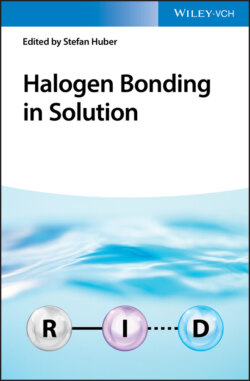Читать книгу Halogen Bonding in Solution - Группа авторов - Страница 41
1.5.4 Supramolecular Gels
ОглавлениеLow molecular weight supramolecular gels can be used for sensing, cell growth media, drug delivery, and stimuli‐responsive optical/electronic materials. Hydrogen bond interactions are commonly used to form 1D or 2D fibrils that are sensitive to competing noncovalent interactions. These competing interactions can therefore be used to control gel formation or gel strength. Metrangolo and Resnati created 1,4‐diiodotetrafluorobenzene and 1,4‐bis(3‐pyridylureido)butane mixtures whose crystal structure revealed a halogen bonding diiodoperfluorobenzene donor, pyridine acceptor, and hydrogen bonding urea donor–acceptor lattice. This combination of molecules resulted in the formation of a supramolecular polymeric gel in dimethyl sulfoxide–water mixtures [189]. This was the first example using a halogen bond to form a supramolecular gel in polar media, suggesting that halogen bonds can operate in the presence of polar solvents and be used for gel‐based materials [190]. The linearity of the halogen bond has also been exploited to develop macroscale materials [191]. By using a halogen bonding 1‐iodoperfluoroalkane donor with a polyethylene glycol‐based ammonium chloride end‐capped acceptor, a star‐shaped polymer was created, which formed millimeter‐sized films without any other external templating forces. Even in the few reported systems, the halogen bond has been versatile enough to produce polymeric gels in competitive media and strong enough to generate millimeter scale assemblies.
Figure 1.20 (a) Chemical structure of the halogen bond and hydrogen bond donors used in nanoparticle formation. (b) Tuning of the poly(4‐vinylpyridine) (P4VP) volume with halogen bond and hydrogen bond donors and transition from lamella–sphere to lamella–lamella morphology.
Source: From Quintieri et al. [186]. © 2018 MDPI.
Figure 1.21 Monomers M1 and M2 were subjected to RAFT polymerization with butyl methacrylate (BMA) to prepare the donor‐containing copolymers P1 and P2, which were methylated to obtain P3 and P4. Acceptor copolymers P5 and P6 were obtained by RAFT polymerization of BMA with methyl methacrylate (MAA) and subsequent treatment with TBAOH.
Source: From Tepper et al. [187]. © 2017 John Wiley & Sons
.
